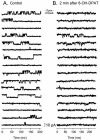5HT1A serotonin receptor agonists inhibit Plasmodium falciparum by blocking a membrane channel
- PMID: 14638487
- PMCID: PMC296210
- DOI: 10.1128/AAC.47.12.3806-3809.2003
5HT1A serotonin receptor agonists inhibit Plasmodium falciparum by blocking a membrane channel
Abstract
To identify new leads for the treatment of Plasmodium falciparum malaria, we screened a panel of serotonin (5-hydroxytryptamine [5HT]) receptor agonists and antagonists and determined their effects on parasite growth. The 5HT1A receptor agonists 8-hydroxy-N-(di-n-propyl)-aminotetralin (8-OH-DPAT), 2,5-dimethoxy-4-iodoamphetamine, and 2,5-dimethoxy-4-bromophenylethylamine inhibited the growth of P. falciparum in vitro (50% inhibitory concentrations, 0.4, 0.7, and 1.5 microM, respectively). In further characterizing the antiparasitic effects of 8-OH-DPAT, we found that this serotonin receptor agonist did not affect the growth of Leishmania infantum, Trypanosoma cruzi, Trypanosoma brucei brucei, or Trichostrongylus colubriformis in vitro and did not demonstrate cytotoxicity against the human lung fibroblast cell line MRC-5. 8-OH-DPAT had similar levels of growth inhibition against several different P. falciparum isolates having distinct chemotherapeutic resistance phenotypes, and its antimalarial effect was additive when it was used in combination with chloroquine against a chloroquine-resistant isolate. In a patch clamp assay, 8-OH-DPAT blocked a P. falciparum surface membrane channel, suggesting that serotonin receptor agonists are a novel class of antimalarials that target a nutrient transport pathway. Since there may be neurological involvement with the use of 8-OH-DPAT and other serotonin receptor agonists in the treatment of falciparum malaria, new lead compounds derived from 8-OH-DPAT will need to be modified to prevent potential neurological side effects. Nevertheless, these results suggest that 8-OH-DPAT is a new lead compound with which to derive novel antimalarial agents and is a useful tool with which to characterize P. falciparum membrane channels.
Figures


Similar articles
-
The stimulus effects of 8-OH-DPAT: evidence for a 5-HT2A receptor-mediated component.Pharmacol Biochem Behav. 2008 Jan;88(3):312-7. doi: 10.1016/j.pbb.2007.09.011. Epub 2007 Sep 19. Pharmacol Biochem Behav. 2008. PMID: 17936346 Free PMC article.
-
Enhancement and depression of spinal reflexes by 8-hydroxy-2-(di-n-propylamino)tetralin in the decerebrated and spinalized rabbit: involvement of 5-HT1A- and non-5-HT1A-receptors.Br J Pharmacol. 1997 Oct;122(4):631-8. doi: 10.1038/sj.bjp.0701430. Br J Pharmacol. 1997. PMID: 9375958 Free PMC article.
-
Effects of galanin on 8-OH-DPAT induced decrease in body temperature and brain 5-hydroxytryptamine metabolism in the mouse.Eur J Pharmacol. 1996 Dec 19;317(2-3):197-204. doi: 10.1016/s0014-2999(96)00716-9. Eur J Pharmacol. 1996. PMID: 8997601
-
The effects of 8-hydroxy-2-(di-n-propylamino)tetralin on the cholinergic contraction in guinea pig and human airways in vitro.Am J Respir Crit Care Med. 1998 Nov;158(5 Pt 1):1479-86. doi: 10.1164/ajrccm.158.5.9712102. Am J Respir Crit Care Med. 1998. PMID: 9817696
-
Pharmacological characterization of in vivo properties of putative mixed 5-HT1A agonist/5-HT(2A/2C) antagonist anxiolytics. II. Drug discrimination and behavioral observation studies in rats.J Pharmacol Exp Ther. 1997 Aug;282(2):747-59. J Pharmacol Exp Ther. 1997. PMID: 9262338
Cited by
-
The principal conductance in Giardia lamblia trophozoites possesses functional properties similar to the mammalian ClC-2 current.Pflugers Arch. 2014 May;466(5):915-24. doi: 10.1007/s00424-013-1350-9. Epub 2013 Sep 17. Pflugers Arch. 2014. PMID: 24043571
-
Host 5-HT affects Plasmodium transmission in mosquitoes via modulating mosquito mitochondrial homeostasis.PLoS Pathog. 2024 Oct 15;20(10):e1012638. doi: 10.1371/journal.ppat.1012638. eCollection 2024 Oct. PLoS Pathog. 2024. PMID: 39405338 Free PMC article.
-
Unravelling the mode of action of the Tres Cantos Antimalarial Set (TCAMS): investigating the mechanism of potent antimalarial compounds potentially targeting the human serotonin receptor.Malar J. 2025 Feb 14;24(1):45. doi: 10.1186/s12936-025-05271-3. Malar J. 2025. PMID: 39953553 Free PMC article.
-
Hormones in malaria infection: influence on disease severity, host physiology, and therapeutic opportunities.Biosci Rep. 2024 Nov 27;44(11):BSR20240482. doi: 10.1042/BSR20240482. Biosci Rep. 2024. PMID: 39492784 Free PMC article. Review.
-
4-aroylpiperidines and 4-(α-hydroxyphenyl)piperidines as selective sigma-1 receptor ligands: synthesis, preliminary pharmacological evaluation and computational studies.Chem Cent J. 2016 Aug 23;10(1):53. doi: 10.1186/s13065-016-0200-1. eCollection 2016. Chem Cent J. 2016. PMID: 27555879 Free PMC article.
References
-
- Alleva, L. M., and K. Kirk. 2001. Calcium regulation in the intraerythrocytic malaria parasite Plasmodium falciparum. Mol. Biochem. Parasitol. 117:121-128. - PubMed
-
- Bitonti, A. J., A. Sjoerdsma, P. P. McCann, D. E. Kyle, A. M. Oduola, R. N. Rossan, W. K. Milhous, and D. E. Davidson, Jr. 1988. Reversal of chloroquine resistance in malaria parasite Plasmodium falciparum by desipramine. Science 242:1301-1303. - PubMed
-
- Delplace, P., B. Fortier, G. Tronchin, J. F. Dubremetz, and A. Vernes. 1987. Localization, biosynthesis, processing and isolation of a major 126 kDa antigen of the parasitophorous vacuole of Plasmodium falciparum. Mol. Biochem. Parasitol. 23:193-201. - PubMed
Publication types
MeSH terms
Substances
LinkOut - more resources
Full Text Sources
Other Literature Sources

